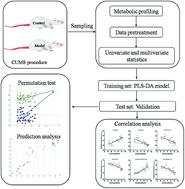A metabolomics-based approach for ranking the depressive level in a chronic unpredictable mild stress rat model†
Abstract
An untargeted metabolomics study to investigate the metabolome change in plasma, hippocampus and prefrontal cortex (PFC) in an animal model with a major depressive disorder (MDD) had been conducted. Metabolomic profiling for the different bio-samples was analyzed by using Ultra-High Performance Liquid Chromatography coupled with Orbitrap mass spectrometry (UPLC-Orbitrap-MS). Behavioral tests were applied to evaluate the depressive degree and antidepressive effect. Then univariate and multivariate statistics including Student's t-test, principal component analysis (PCA) and partial least squares discriminant analysis (PLS-DA) were applied to reveal the metabolic differences between the control, model and antidepressive-treated groups. Metabolomics analysis demonstrated that MDD was a kind of systemic disease in which disturbance of neuroendocrinology, amino acid metabolism, energy metabolism, lipid metabolism and synthesis of neurotransmitters were involved. The significantly changed metabolites acquired from the statistical method were identified and a simplified panel which consisted of 6 metabolites including L-tryptophan, L-kynurenine, quinolinic acid, L-phenylalanine, gamma-aminobutyric acid and N-acetylaspartic acid was obtained. In combination with the results of the sucrose preference test, a new PLS-DA model conducted by the identified changed metabolome showed a good predictive power which meant the metabolome was able to rank the depressive level as the behavioral test. Then correlational analysis indicated the simplified panel in plasma had a relative good correlation with that in hippocampus and PFC. This study offers a new strategy for characterization of endogenous metabolic perturbations by a metabolomics method and the good predictive power and correlation for the significantly changed metabolome between plasma and brain regions which might be helpful in ranking the depressive level in the CUMS model. These results are helpful in the further study to develop a noninvasive and exact diagnostic approach by an objective laboratory-based test through the metabolomics platform.


 Please wait while we load your content...
Please wait while we load your content...